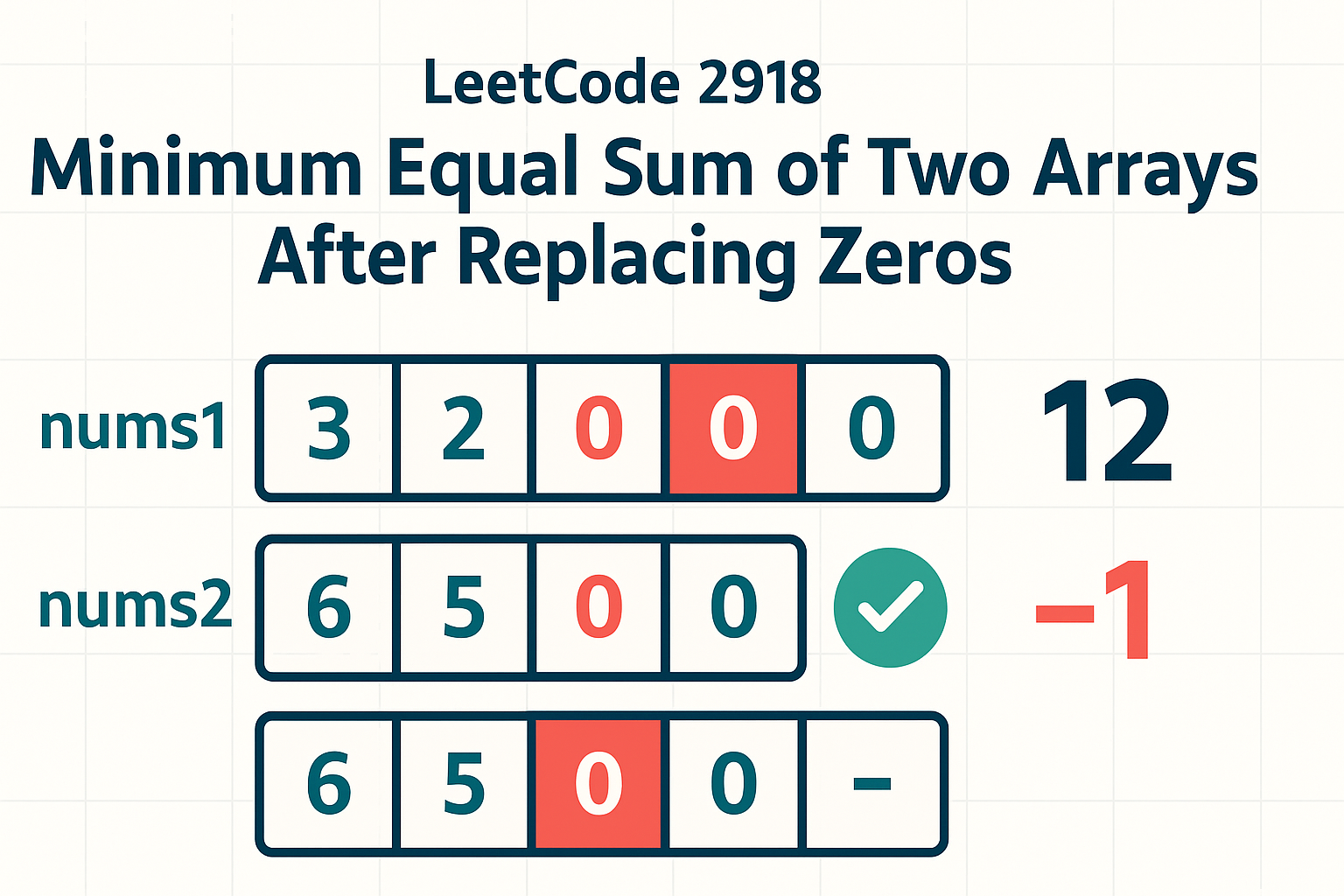
2918: Minimum Equal Sum of Two Arrays After Replacing Zeros
Problem Statement
Given two arrays containing positive integers and zeros, replace all zeros with positive integers such that both arrays have equal sums. Return the minimum possible equal sum or -1 if impossible.
Example 1
Input: nums1 = [3,2,0,1,0], nums2 = [6,5,0]
Output: 12
Explanation: Replace zeros with [2,4] in nums1 and [1] in nums2Example 2
Input: nums1 = [2,0,2,0], nums2 = [1,4]
Output: -1
Explanation: Impossible to balance sumsApproach 1: Mathematical Analysis
Calculate base sums and zero counts to determine minimal possible sum.
Algorithm Steps
- Calculate sum1 (sum of non-zero elements in nums1) + count of zeros
- Calculate sum2 (sum of non-zero elements in nums2) + count of zeros
- Determine valid minimal sum based on relationships:
- sum1 < sum2 → Check if sum2 ≤ sum1 + zeros1*inf
- sum2 < sum1 → Check if sum1 ≤ sum2 + zeros2*inf
- If both have zeros → max(base_sum1 + 1, base_sum2 + 1)
Complexity Analysis
| Time Complexity | Space Complexity |
|---|---|
| O(n + m) | O(1) |
class Solution {
public:
long long minSum(vector<int>& nums1, vector<int>& nums2) {
long long sum1 = 0, sum2 = 0;
int zero1 = 0, zero2 = 0;
for(int num : nums1) {
if(num == 0) zero1++;
sum1 += num;
}
for(int num : nums2) {
if(num == 0) zero2++;
sum2 += num;
}
long long base1 = sum1 + zero1;
long long base2 = sum2 + zero2;
if(zero1 == 0 && base1 < base2) return -1;
if(zero2 == 0 && base2 < base1) return -1;
if(zero1 == 0 && zero2 == 0) {
return sum1 == sum2 ? sum1 : -1;
}
return max(base1, base2);
}
};class Solution {
public long minSum(int[] nums1, int[] nums2) {
long sum1 = 0, sum2 = 0;
int zero1 = 0, zero2 = 0;
for(int num : nums1) {
if(num == 0) zero1++;
sum1 += num;
}
for(int num : nums2) {
if(num == 0) zero2++;
sum2 += num;
}
long base1 = sum1 + zero1;
long base2 = sum2 + zero2;
if(zero1 == 0 && base1 < base2) return -1;
if(zero2 == 0 && base2 < base1) return -1;
if(zero1 == 0 && zero2 == 0) {
return sum1 == sum2 ? sum1 : -1;
}
return Math.max(base1, base2);
}
}class Solution:
def minSum(self, nums1: List[int], nums2: List[int]) -> int:
sum1, zero1 = 0, 0
sum2, zero2 = 0, 0
for num in nums1:
if num == 0:
zero1 += 1
sum1 += num
for num in nums2:
if num == 0:
zero2 += 1
sum2 += num
base1 = sum1 + zero1
base2 = sum2 + zero2
if zero1 == 0 and base1 < base2:
return -1
if zero2 == 0 and base2 < base1:
return -1
if zero1 == 0 and zero2 == 0:
return sum1 if sum1 == sum2 else -1
return max(base1, base2)Key Mathematical Observations
| Condition | Calculation | Reasoning |
|---|---|---|
| Both arrays have zeros | max(base1, base2) | Each zero adds at least 1, take maximum base |
| One array has zeros | Check feasibility | Non-zero array's sum must ≤ potential sum |
| No zeros | Compare sums | Direct equality check required |
Edge Case Analysis
1. All Zeros
nums1 = [0,0], nums2 = [0] → min sum = 32. No Zeros
nums1 = [5,5], nums2 = [10] → sum = 103. One Array Dominant
nums1 = [10,0], nums2 = [5,5] → min sum = 11Frequently Asked Questions
1. Why add 1 for each zero in base sum?
Each zero must be replaced by at least 1, contributing minimally to the sum.
2. How does the solution handle large numbers?
Uses long integers to prevent overflow, crucial for arrays with 1e5 elements.
3. Why use max(base1, base2)?
Both arrays must reach the same sum, so we need to satisfy the higher base requirement.
4. What if one array has higher non-zero sum but more zeros?
The algorithm automatically selects the maximum base sum to ensure both can reach it.
5. Can zeros be replaced with values greater than 1?
Yes, but the minimal sum requires using the smallest possible replacements (1s).
6. How to verify solution correctness?
Check that: 1) Final sums match, 2) All replacements are positive, 3) No better solution exists.
7. What's the time complexity breakdown?
O(n + m) for array traversal + O(1) calculations. Optimal for large inputs.
8. Why return -1 for some cases?
When constraints make balancing impossible (e.g., fixed sum already too high).
9. How to handle multiple zero replacements?
All zeros must be ≥1, but optimal solution uses exactly 1 for minimal contribution.
10. Practical applications of this problem?
Resource allocation, data balancing, and constraint satisfaction problems.